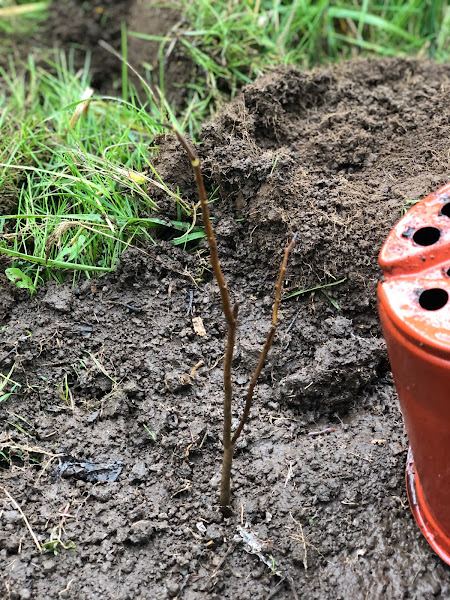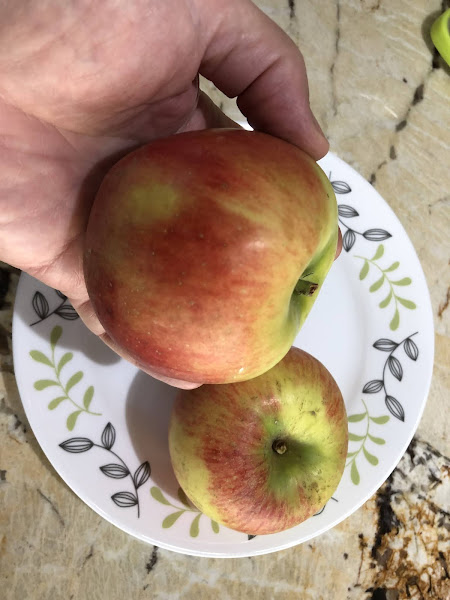Sunday, October 10, 2021
Planting Some Pawpaw Starts. 10.10.21
A few years ago, I planted some pawpaw seeds. Quite a few sprouted. I didn't take good care of them. The plants got eaten by deer, knocked over, dried out. This year I repotted the survivors, then they were subjected to 114 F heat. This was the "Squid Games" of pawpaw trees.
Also, there was one in the orchard whose top had died. Sprouts came up from the bottom, but someone mowed over them. Then new sprouts grew through the hardware cloth vole protector, which tore the sprouts when I removed the mesh. I dug that up and now there is a handsome young aspen tree in its place.
Today I planted two of the surviving seedlings, and the abused transplant, in a shadier spot in the apple tree mini orchard. If they survive, I want to pamper them next yea with lots of water and fertilizer.
Here is the better looking of the group. It was watered more than the others, because I had it in my baby Forsythia nursery. I don't know why the others weren't there too.
Here is a blurry version of one of the others. It's not fair that the other one got better treatment, but unfairness is central to the Squid Game, even if you are a pawpaw.
Moving a Tall, Young Aspen Tree. 10.10.21
A few years ago, the aspen tree that I planted in 2012 sent off an underground shoot, terminating in a baby aspen tree. That's one way they reproduce, like amoebas. I cut off that shoot and planted it behind the woodshed. That wasn't very smart, because it's very shady back there. Plus, I needed to put up a deer guard fence which is always messy, encourages blackberry brambles, and was in the way of me getting into the woodshed.
Today I moved it to an entirely different spot. I had to dig up a sad little pawpaw tree whose top and died and the new shoot wasn't looking great.
The Aspen tree and its roots. I will be filled with a sense of awe if a tree with so minimal roots actually survives. Rainy season / Fall / October is actually a good time do do it.
I had actually tried not to cut off too much root, but the root system was too long and sprawling for me to dig up. Still, I've planted trees almost as tall, with even fewer roots, and they thrived. So we will see.
According to WA State Arborist Lind Chalker Scott (if memory serves correctly, I should not shorten the top, so I wont. Also, it's usually recommended not to tie a transplanted tree to stakes, but thus one is so ungangly and top heavy, I'm certain it will fall over and uproot itself. Do unstaking will need to wsit a year or too.
We'll see if it grows. Each Fall I try to plant another shade treein honor of my pasding another rotation around the sun, and I think this one counts.
Wednesday, October 06, 2021
Winter Shelter for Genetic Dwarf Peach Tree. 10.6.2021
I finished this a few days ago.
Genetic dwarf peach trees should be ideal size for a senior gardener. They generally remain about four feet tall. I had one a few years ago that reached 5 feet tall in about 10 years.
Genetic Dwarf peach trees bear somewhat smaller peaches, compared to "normal" peach trees, but they are full flavor, delicious genuine peaches. They bloom like crazy and bear like crazy for such small trees.
The challenge is, winter rains in the Pacific NW bring severe fungal infections - debilitating, horrible, often fatal Peach Leaf Curl (PLC) disease. There are a few resistant or semi resistant full sized peach varieties, but all genetic dwarf varieties are highly susceptible. It's kind of heartbreaking, like peach tree leprosy. It's very frustrating, limits yield greatly, and damages the tree badly.
Supposedly, antifungal sprays can help. I have a hard time getting it right with type of spray and timing.
It does help if the tree can be protected from winter rain. I've tried growing them in containers, and moving the tree out of the rain in the fall, through winter and early spring. However, if th container isn't gigantic, it will dry out rapidly and require two or more waterings a day all summer long. Otherwise it dries out and stresses the tree. Also, it's way too top heavy. Mine kept falling over.
I also tried tying up the branches into a bundle, and covering with garbage bag for the winter. That sort of works, but is a challenge. Last winter, I covered my two little, new, genetic dwarf peach trees with upturned garbage cans. That was somewhat successful, but I didn't realize when they were growing, they bloomed in the dark and didn't set any fruit. Plus, it was still raining so they were somewhat affected by PLC anyway.
My original plan with these miniature trees in my accessible garden, was to build a permanent frame that I could install a plastic cover for the winter. I finally did that now. Since one is much larger than the other, it also has a larger shelter. I think this has a chance. The trees will need regular pruning. No problem there. I hope it works.
Tuesday, October 05, 2021
Propagating Forsythia by Ground Layering. 10.5.2021
This Spring, I did an experiment to propagate forsythia. My plan was to start a forsythia hedge. I estimated I would need about 12 bushes for a nice hedge. I rooted some cuttings in water (worked very well, and very easy to do). I started some using rooting hormone in seed starting medium (it worked, but slower, more trouble, more delicate cuttings and the plants are much smaller so far). I also bent three stems of the original bush low, digging a hole for each. I bent them so about a foot of the stem was in the hole, with the top sticking out. I filled the hole with soil. I think I watered them two or three times during the summer.
Yesterday I dug up two of those starts, cutting their connection to the original bush.
These were excellent starts. Vigorous, with hefty root systems. It's rainy season, Fall now, so they will be off to a great start.
I have one more layered start, one more water started cutting, and a few very small seed starting medium cuttings remaining to plant the row. I have planted nine so far. They will be a nice hedge, beautiful flowers in Springs to come and increasingly effective as a privacy hedge in a year or two or three.
When I priced potted forsythia bushes lasrpt Spring, the smallest of these were $11 and the largest were $30. By being a little patient and doing it myself from cuttingscate cuttings or layering, this is a roughly $150 hedge, for no cost at all.
The First of the Columnar Apple, Tasty Red™. 10.5.2021
This columnar tree is in my accessible "Senior Citizen" (me) fenced garden. The top died, I think due to anthracnose, but lower branches survived. This "tree", currently about fout feet tall, bore it's first two apples which I picked this week.
These are marketed as deep red.
These apples have a nice juicy crisp texture, nice sweetness and apple flavor. I think it is a good addition for the accessible garden. I'm happy with this apple.
Subscribe to:
Posts (Atom)
 t
t







